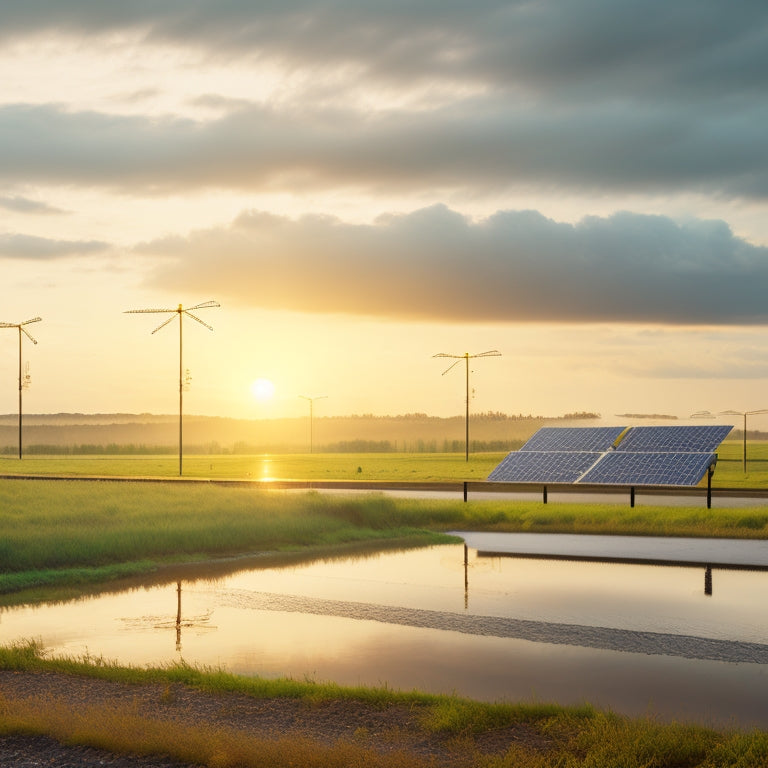
Harvest Rain to Clean Solar Panels Efficiently
Share
By harvesting rainwater, you can efficiently clean your solar panels while reducing your reliance on municipal water supplies and minimizing environmental impact. This approach also promotes sustainable practices, lowers energy expenses, and increases your energy independence. Regular cleaning with rainwater helps maintain peak panel performance, and with automated systems, you can reduce water bills and enhance panel lifespan. As you investigate the benefits of rainwater harvesting for solar panel maintenance, you'll reveal more ways to optimize your system's efficiency and cost savings, unfastening a brighter, more sustainable energy future ahead.
Key Takeaways
- Harvesting rainwater reduces reliance on municipal water supplies, decreasing environmental impact and promoting sustainable practices.
- Rainwater is a natural cleaning agent, effectively removing dirt and debris from solar panels, and can be used with automated cleaning systems.
- Regular cleaning with harvested rainwater can enhance solar panel efficiency by up to 20%, translating to higher energy output and savings.
- Customized rainwater harvesting systems with compatible equipment, proper installation, and maintenance are crucial for efficient and cost-effective cleaning.
- Scheduling cleaning every 6-12 months with harvested rainwater extends panel lifespan, reduces maintenance costs, and supports renewable energy goals.
Benefits of Rainwater Harvesting
You can considerably reduce your reliance on municipal water supplies by harvesting rainwater, which offers several benefits. By collecting and storing rainwater, you'll decrease your environmental impact, as it reduces the amount of stormwater runoff that can pollute nearby waterways.
Rainwater harvesting also promotes sustainable practices, as it decreases the demand on municipal water treatment facilities. Implementing regular maintenance, including cleaning and inspecting connections, is essential for optimizing performance and ensuring longevity, as regular cleaning of solar panels can prevent up to 20% efficiency loss.
Additionally, using rainwater for non-potable purposes, like cleaning solar panels, conserves potable water for drinking and other essential uses. This approach not only helps the environment but also gives you more control over your water usage, cultivating independence from municipal supplies.
Choosing the Right Equipment
Harvesting rain for solar panels requires a well-designed system, and selecting the right equipment is vital to its success. When choosing equipment, you'll need to take into account the types of equipment required, such as roof catchments, gutters, downspouts, and storage tanks.
Confirm system compatibility by selecting equipment that fits your specific solar panel setup and rainwater harvesting goals. It's imperative to follow proper installation and maintenance procedures, such as those outlined in the solar panel installation guide, to guarantee the longevity of your equipment.
For instance, if you have a large solar panel array, you'll need a larger storage tank to hold the collected rainwater. Research different equipment types and their features to find the best fit for your system.
Assess factors like durability, corrosion resistance, and ease of maintenance to make sure your equipment lasts for years to come.
Installation and Maintenance Tips
As the rainwater harvesting system begins to take shape, proper installation and maintenance become essential to guaranteeing its best performance and longevity.
You'll want to ascertain that your system design is customized to your specific needs, considering factors like roof size, rainfall patterns, and water storage capacity.
Additionally, incorporating eco-friendly stops with solar canopies and rainwater systems for sustainability can enhance the overall efficiency of the system.
For instance, sustainable station designs can feature green roofs, rainwater harvesting, and solar panels.
To keep your system running smoothly, perform the following routine checks:
- Inspect the roof catchment: Clear debris from the gutters and downspouts to guarantee proper water flow.
- Check the first flush device: Verify that it's functioning correctly to prevent contaminants from entering the storage tank.
- Monitor water quality: Regularly test the water for pH, turbidity, and bacterial contamination.
- Perform routine cleaning: Clean the solar panels and system components to maintain efficiency and prevent clogging.
Rainwater Storage Options
Rainwater storage tanks are a critical component of any rainwater harvesting system, serving as a reservoir for collected water until it's needed for solar panel cleaning or other purposes.
You'll need to decide on the right storage option for your system, considering factors like space, budget, and water usage. In addition, it's important to make sure that your solar energy solution is environmentally sustainable, reducing fossil fuel reliance and promoting eco-friendly energy sources.
A simple rain barrel is a cost-effective choice, ideal for small-scale harvesting. It can be installed above or below ground, and typically holds up to 1,000 gallons.
For larger systems, an underground cistern is a more suitable option, offering greater storage capacity and reduced visual impact.
Whichever you choose, make certain it's durable, watertight, and easily accessible for maintenance and cleaning.
Cleaning Solar Panels Efficiently
You've invested in a solar panel system to reduce your carbon footprint, and now it's essential to maintain its efficiency by keeping those panels clean.
Dirty panels can reduce solar panel efficacy by up to 25%, which is why regular cleaning is necessary. Conducting energy audits and load profiling, as discussed in solar charging infrastructure, can help identify ideal cleaning schedules for your solar panels.
Additionally, designing charging layouts with accessibility and safety in mind can also facilitate the cleaning process.
To clean your solar panels efficiently, consider the following eco-friendly solutions:
- Use harvested rainwater: Reduce your water bill and reliance on municipal water supplies by using collected rainwater to clean your solar panels.
- Invest in a solar panel cleaning system: Automated systems can help you clean your panels regularly, ensuring peak performance.
- Utilize microfiber cloths and mild soap: Avoid using harsh chemicals that can damage your panels; instead, opt for eco-friendly cleaning solutions.
- Schedule regular cleaning: Set a reminder to clean your panels every 6-12 months to maintain peak performance and extend their lifespan.
Cost Savings and ROI Analysis
By utilizing rainwater to clean your solar panels, you'll reduce energy expenses by maximizing their power output.
This efficient cleaning method also increases panel longevity, saving you money on replacement and maintenance costs.
As you'll soon see, the ROI analysis will demonstrate how these cost savings can add up quickly.
Reduced Energy Expenses
Utilizing rainwater to clean solar panels can greatly reduce your energy expenses. By leveraging the power of nature, you can conserve energy and allocate it towards more critical aspects of your life. This sustainable practice not only helps you save money but also contributes to a greener environment.
Here's how:
-
Decreased energy consumption: Rainwater cleaning eliminates the need for energy-intensive cleaning methods, resulting in lower energy bills.
-
Optimized panel performance: Clean panels guarantee maximum energy output, reducing the strain on your energy resources.
-
Reduced reliance on public utilities: By conserving energy, you're less dependent on public utilities, giving you more control over your energy needs.
- Long-term cost savings: This energy conservation strategy leads to significant cost savings over time, providing you with more financial freedom.
Increased Panel Longevity
Cleaning solar panels with rainwater extends their lifespan, translating to significant cost savings and a higher return on investment (ROI).
You'll benefit from reduced panel degradation, as dirt and debris won't accumulate and cause premature wear. Weather impact, such as extreme temperatures and UV radiation, will also have less effect on your panels' performance.
By using rainwater to clean your solar panels, you'll maintain their peak energy output, ensuring you generate the most electricity possible. This means you'll enjoy increased energy independence and lower your reliance on the grid.
With longer-lasting panels, you'll see a higher ROI and more savings in your pocket.
Frequently Asked Questions
Can I Use Rainwater Harvesting for Other Purposes Beyond Cleaning Solar Panels?
You're not thinking big enough if you believe rainwater harvesting stops at cleaning solar panels! You can actually employ rainwater for irrigation, toilet flushing, and even drinking water, promoting sustainable practices and reducing your reliance on municipal supplies.
Is Rainwater Harvesting Suitable for Areas With Low Rainfall?
You'll face low rainfall challenges, but rainwater harvesting can still be beneficial, even in areas with limited precipitation, as it reduces your reliance on municipal supplies, conserves this precious resource, and offers a sustainable solution for your needs.
How Often Should I Inspect My Rainwater Harvesting System?
In Perth, Australia, a homeowner's quarterly inspections of their rainwater harvesting system prevented clogging and contamination issues, ensuring reliable water supply; you should inspect your system every 3-6 months to maintain efficiency and prevent costly repairs.
Are There Any Local Regulations Governing Rainwater Harvesting Systems?
You'll need to research local legal requirements, obtaining necessary system permits, and complying with ordinances before installing your rainwater harvesting system, ensuring you're not violating any laws and avoiding potential fines or penalties.
Can I Integrate My Rainwater Harvesting System With Existing Irrigation Systems?
You can integrate your rainwater harvesting system with existing irrigation systems by incorporating rainwater filtration to guarantee water quality, ultimately enhancing irrigation efficiency and giving you more control over your water usage.
Related Posts
-

3 Ways Wind Power Boosts Home Value
Living near a wind farm can enhance your property's value in three significant ways. To begin with, proximity to wind...
-

Why Biodegradable Dish Soap Matters for Earth-Conscious Homes
You likely don't realize that the dish soap you're using today will still be harming the environment long after you'v...
-

Why Choose Solar Composting Toilets for Your Home?
By choosing a solar composting toilet for your home, you'll greatly reduce your environmental impact, slashing your w...


